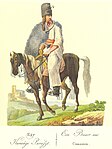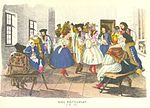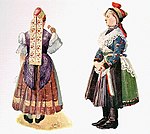Hungarians
Magyarok | |||||||||||||||||||||||||||||||||||||||||||||||||||||||
|---|---|---|---|---|---|---|---|---|---|---|---|---|---|---|---|---|---|---|---|---|---|---|---|---|---|---|---|---|---|---|---|---|---|---|---|---|---|---|---|---|---|---|---|---|---|---|---|---|---|---|---|---|---|---|---|
 Ethnic distribution of Hungarians worldwide | |||||||||||||||||||||||||||||||||||||||||||||||||||||||
| Total population | |||||||||||||||||||||||||||||||||||||||||||||||||||||||
| c. 14.5 million | |||||||||||||||||||||||||||||||||||||||||||||||||||||||
| Regions with significant populations | |||||||||||||||||||||||||||||||||||||||||||||||||||||||
| Other countries | |||||||||||||||||||||||||||||||||||||||||||||||||||||||
| |||||||||||||||||||||||||||||||||||||||||||||||||||||||
| |||||||||||||||||||||||||||||||||||||||||||||||||||||||
| |||||||||||||||||||||||||||||||||||||||||||||||||||||||
| |||||||||||||||||||||||||||||||||||||||||||||||||||||||
| Languages | |||||||||||||||||||||||||||||||||||||||||||||||||||||||
| Person | Magyar |
|---|---|
| People | Magyarok |
| Language | Magyar nyelv, Magyar jelnyelv |
| Country | Magyarország |
Hungarians, also known as Magyars (/ˈmæɡjɑːrz/ MAG-yarz;[26] Hungarian: magyarok [ˈmɒɟɒrok]), are a Central European nation and an ethnic group native to Hungary (Hungarian: Magyarország) and historical Hungarian lands (i.e. belonging to the former Kingdom of Hungary) who share a common culture, history, ancestry, and language. The Hungarian language belongs to the Uralic language family, alongside, most notably Finnish and Estonian.
There are an estimated 14.5 million ethnic Hungarians and their descendants worldwide, of whom 9.6 million live in today's Hungary.
Furthermore, Hungarians can be divided into several subgroups according to local linguistic and cultural characteristics; subgroups with distinct identities include the Székelys (in eastern Transylvania as well as a few in Suceava County, Bukovina), the Csángós (in Western Moldavia), the Palóc, and the Matyó.
Name
The Hungarians' own ethnonym to denote themselves in the Early Middle Ages is uncertain. The
Prior to the
In the Hungarian language, the Hungarian people name themselves as "Magyar".[28] "Magyar" possibly derived from the name of the most prominent Hungarian tribe, the "Megyer". The tribal name "Megyer" became "Magyar" in reference to the Hungarian people as a whole.[30][31][32]
The Greek
The obscure name kerel or keral, found in the 13th-century work
The historical Latin phrase "Natio Hungarica" ("Hungarian nation") had a wider and political meaning because it once referred to all nobles of the Kingdom of Hungary, regardless of their ethnicity or mother tongue.[39]
History
Origin
The origin of Hungarians, the place and time of their
The historical Magyar conquerors were found to show significant affinity to modern
"
Pre-4th century AD

During the 4th millennium BC, the Uralic-speaking peoples who were living in the central and southern regions of the Urals split up. Some dispersed towards the west and northwest and came into contact with Turkic and Iranian speakers who were spreading northwards.[45] From at least 2000 BC onwards, the Ugric-speakers became distinguished from the rest of the Uralic community, of which the ancestors of the Magyars, being located farther south, were the most numerous. Judging by evidence from burial mounds and settlement sites, they interacted with the Indo-Iranian Andronovo culture and Baikal-Altai Asian cultures.[46][43]
4th century to c. 830
In the 4th and 5th centuries AD, the Hungarians were an "[e]thnically mixed people"
The Hungarians around the Don River were subordinates of the
c. 830 to c. 895
Around 830, a rebellion broke out in the Khazar khaganate. As a result, three
Entering the Carpathian Basin (c. 862–895)

The Hungarians arrived in the Carpathian Basin, a geographically unified but politically divided land, after acquiring thorough local knowledge of the area from the 860s onwards.[51][52][53][54][55][56][57]
After the end of the Avar Kaganate (c. 822), the Eastern Franks asserted their influence in Transdanubia, the Bulgarians to a small extent in the Southern Transylvania and the interior regions housed the surviving Avar population in their stateless state.[52][58] The downfall of the Avar Khaganate at the beginning of the 9th century did not mean the extinction of the Avar population, contemporary written sources report surviving Avar groups.[53] According to the archaeological evidence, the Avar population survived the time of the Hungarian conquest of the Carpathian Basin.[52][56][59] In this power vacuum, the Hungarian conqueror elite took the system of the former Avar Kaganate, there is no trace of massacres and mass graves, it is believed to have been a peaceful transition for local residents in the Carpathian Basin.[59] The Hungarian conquerors together with the Turkic-speaking Kabars integrated the Avars and Onogurs.[60]
In 862, Prince
The foundation of the Hungarian state is connected to the Hungarian conquerors, who arrived from the Pontic steppes as a confederation of seven tribes. The Hungarians arrived in the frame of a strong centralized steppe-empire under the leadership of Grand Prince Álmos and his son Árpád, they became founders of the Árpád dynasty, the Hungarian ruling dynasty and the Hungarian state. The Árpád dynasty claimed to be a direct descendant of the great Hun leader Attila.[71][72][73] Medieval Hungarian chronicles from the Hungarian royal court like the Gesta Hungarorum, Gesta Hunnorum et Hungarorum, Chronicon Pictum, Buda Chronicle, Chronica Hungarorum claimed that the Árpád dynasty and the Aba clan are the descendants of Attila.[71]
Árpád, Grand Prince of the Hungarians, says in the Gesta Hungarorum:
The land stretching between the Danube and the Tisza used to belong to my forefather, the mighty Attila.
The Hungarians took possession of the Carpathian Basin in a pre-planned manner, with a long move-in between 862 and 895.[51][52][54][55][56][58][63][75] This is confirmed by the archaeological findings, in the 10th-century Hungarian cemeteries, the graves of women, children and elderly people are located next to the warriors, they were buried according to the same traditions, wore the same style of ornaments, and belonged to the same anthropological group. The Hungarian military events of the following years prove that the Hungarian population that settled in the Carpathian Basin was not a weakened population without a significant military power.[56] Other theories assert that the move of the Hungarians was forced or at least hastened by the joint attacks of Pechenegs and Bulgarians.[56][76] According to eleventh-century tradition, the road taken by the Hungarians under Prince Álmos took them first to Transylvania in 895. This is supported by an eleventh-century Russian tradition that the Hungarians moved to the Carpathian Basin by way of Kiev.[77] Prince Álmos, the sacred leader of the Hungarian Great Principality died before he could reach Pannonia, he was sacrificed in Transylvania.[61][78]
In 895/896, under the leadership of
From the upper Tisza region of the Carpathian Basin, the Hungarians intensified their campaigns across continental Europe. In 900, they moved from the upper Tisza river to Transdanubia, which later became the core of the arising Hungarian state. By 902, the borders were pushed to the South-Moravian Carpathians and the Principality of Moravia collapsed.[79] At the time of the Hungarian migration, the land was inhabited only by a sparse population of Slavs, numbering about 200,000,[48] who were either assimilated or enslaved by the Hungarians.[48]
Archaeological findings (e.g. in the Polish city of Przemyśl) suggest that many Hungarians remained to the north of the Carpathians after 895/896.[80] There is also a consistent Hungarian population in Transylvania, the Székelys, who comprise 40% of the Hungarians in Romania.[81][82] The Székely people's origin, and in particular the time of their settlement in Transylvania, is a matter of historical controversy.
After 900
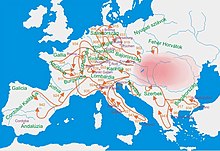
In 907, the Hungarians destroyed a
The Pope approved Hungarian settlement in the area when their leaders converted to Christianity, and Stephen I (Szent István, or Saint Stephen) was crowned King of Hungary in 1001. The century between the arrival of the Hungarians from the eastern European plains and the consolidation of the Kingdom of Hungary in 1001 was dominated by pillaging campaigns across Europe, from Dania (Denmark) to the Iberian Peninsula (contemporary Spain and Portugal).[citation needed] After the acceptance of the nation into Christian Europe under Stephen I, Hungary served as a bulwark against further invasions from the east and south, especially by the Turks.

At this time, the Hungarian nation numbered around 400,000 people.[48]
Early modern period
The first accurate measurements of the population of the Kingdom of Hungary including ethnic composition were carried out in 1850–51. There is a debate among Hungarian and non-Hungarian (especially Slovak and Romanian) historians about the possible changes in the ethnic structure of the region throughout history. Some historians support the theory that the proportion of Hungarians in the Carpathian Basin was at an almost constant 80% during the Middle Ages.[85] Non-Hungarians numbered hardly more than 20% to 25% of the total population.[citation needed] The Hungarian population began to decrease only at the time of the Ottoman conquest, reaching as low as around 39% by the end of the 18th century.[citation needed]
The decline of the Hungarians was due to the constant wars, Ottoman raids, famines, and plagues during the 150 years of Ottoman rule.[citation needed] The main zones of war were the territories inhabited by the Hungarians, so the death toll depleted them at a much higher rate than among other nationalities.[citation needed] In the 18th century, their proportion declined further because of the influx of new settlers from Europe, especially Slovaks, Serbs and Germans.[86] In 1715 (after the Ottoman occupation), the Southern Great Plain was nearly uninhabited but now has 1.3 million inhabitants, nearly all of them Hungarians. As a consequence, having also the Habsburg colonization policies, the country underwent a great change in ethnic composition as its population more than tripled to 8 million between 1720 and 1787, while only 39% of its people were Hungarians, who lived primarily in the centre of the country.[87]


19th century to present
In the 19th century, the proportion of Hungarians in the Kingdom of Hungary rose gradually, reaching over 50% by 1900 due to higher natural growth and


The years 1918 to 1920 were a turning point in the Hungarians' history. By the
The number of Hungarians in the neighbouring countries tended to remain the same or slightly decreased, mostly due to assimilation (sometimes forced; see
For historical reasons (see
There was a referendum in Hungary in December 2004 on whether to grant Hungarian citizenship to Hungarians living outside Hungary's borders (i.e. without requiring a permanent residence in Hungary). The referendum failed due to insufficient voter turnout. On 26 May 2010, Hungary's Parliament passed a bill granting dual citizenship to ethnic Hungarians living outside of Hungary. Some neighboring countries with sizable Hungarian minorities expressed concerns over the legislation.[95]
Ethnic affiliations and genetic origins


Modern Hungarians stand out as linguistically isolated in Europe, despite their genetic similarity to the surrounding populations. The population of the
The
Archeological mtDNA haplogroups show a similarity between Hungarians and Turkic-speaking Tatars and Bashkirs, while another study found a link between the Mansi and Bashkirs, suggesting that the Bashkirs are a mixture of Turkic, Ugric and Indo-European contributions. The homeland of ancient Hungarians is around the Ural Mountains, and the Hungarian affinities with the Karayakupovo culture is widely accepted among researchers.[111][112] A full genome study found that the Bashkirs display, next to their high European ancestry, also affinity to both Uralic-speaking populations of Northern Asia, as well as Inner Asian Turkic groups, "pointing to a mismatch of their cultural background and genetic ancestry and an intricacy of the historic interface between Turkic and Uralic populations".[113]
The homeland of the proto-Uralic peoples may have been close to Southern Siberia, among forest cultures in the Altai-Sayan region and may be linked to an ancestry maximized in the early
Neparáczki et al. argues, based on archeogenetic results, that the historical Hungarian Conquerors were mostly a mixture of Central Asian Steppe groups, Slavic, and Germanic tribes, and this composite people evolved between 400 and 1000 AD.[115][116] According to Neparáczki: "From all recent and archaic populations tested the Volga Tatars show the smallest genetic distance to the entire Conqueror population" and "a direct genetic relation of the Conquerors to Onogur-Bulgar ancestors of these groups is very feasible."[117] Genetic data found high affinity between Magyar conquerors, the historical Bulgars, and modern day Turkic-speaking peoples in the Volga region, suggesting a possible language shifted from an Uralic (Ugric) to Turkic languages.[118]
Paternal haplogroups
Hungarian males possess a high frequency of haplogroup R1a-Z280 and a low frequency of haplogroup N-Tat, which is uncommon among most Uralic-speaking populations.
In the case of the Southern Mansi males, the most frequent haplogroups were N1b-P43 (33%), N1c-L1034 (28%) and R1a-Z280 (19%).The Konda Mansi population shared common haplotypes within haplogroups R1a-Z280 or N-M46 with Hungarian speakers, which may suggest that the Hungarians were in contact with the Mansi people during their migration to the Carpathian Basin.[123]
According to a study by Pamjav, the area of Bodrogköz suggested to be a population isolate found an elevated frequency of Haplogroup N: R1a-M458 (20.4%), I2a1-P37 (19%), R1a-Z280 (14.3%), and E1b-M78 (10.2%). Various R1b-M343 subgroups accounted for 15% of the Bodrogköz population. Haplogroup N1c-Tat covered 6.2% of the lineages, but most of it belonged to the N1c-VL29 subgroup, which is more frequent among Balto-Slavic speaking than Finno-Ugric speaking peoples. Other haplogroups had frequencies of less than 5%.[124]
Among 100 Hungarian men, 90 of whom from the
An analysis of Bashkir samples from the
Historical Magyar conquerors had around ~37.5% Haplogroup N-M231, as well as lower frequency of Haplogroup C-M217 at 6.25% with the remainder being Haplogroup R1a and Haplogroup Q-M242.[43]
Autosomal DNA
Modern Hungarians show relative close affinity to surrounding populations, but harbour a small "Siberian" component associated with Khanty/Mansi, as well as the Nganasan people, and argued to have arrived with the historical Magyars. Modern Hungarians formed from several historical population groupings, including the historical Magyars, assimilated Slavic and Germanic groups, as well as Central Asian Steppe tribes (presumably Turkic and Iranian tribes).[43][131][113][132][40][105]
The historical Magyar genome corresponds largely with the modern Bashkirs, and can be modeled as ~50% Khanty/Mansi-like, ~35% Sarmatian-like, and ~15% Hun/Xiongnu-like. The admixture event is suggested to have taken place in the Southern Ural region at 643–431 BCE. Modern Hungarians were found to be admixed descendants of the historical Magyar conquerors with local Europeans, as 31 Hungarian samples could be modelled as two-way admixtures of "Conq_Asia_Core" and "EU_Core" in varying degrees. The historical Magyar component among modern Hungarians is estimated at an average frequency of 13%, which can be explained by the relative smaller population size of Magyar conquerors compared to local European groups.[43][131]
Other influences
Besides the various peoples mentioned above, the Magyars were later influenced by other populations in the Carpathian Basin. Among these are the Cumans, Pechenegs, Jazones, West Slavs, Germans (more specifically Hungarian Germans but also Transylvanian Saxons or other ethnic German minorities in the former Kingdom of Hungary or in Central and Eastern Europe such as the Zipser Germans), and Vlachs (Romanians).
Ottomans, who occupied the central part of Hungary from c. 1526 until c. 1699, inevitably exerted an influence, as did the various nations (Germans/Banat Swabians, Slovaks, Serbs, Croats, and others) that resettled the depopulated central and southern territories of the kingdom (roughly present-day South Hungary, Vojvodina in Serbia and Banat in Romania) after their departure. Similar to other European countries, Armenian, and Roma (Gypsy) ethnic minorities have been living in Hungary since the Middle Ages. Jews have been living in Hungary since the Roman era, as the archeological evidence of Jewish gravestones dating from this period demonstrates.
Diaspora

Hungarian diaspora (Magyar diaspora) is a term that encompasses the total ethnic Hungarian population located outside of current-day Hungary.
-
Hungarians in Romania(according to the 2021 census)
-
Hungarians in Vojvodina, Serbia (according to the 2002 census)
-
Hungarians in Slovakia (according to the 2011 census)
-
Hungarians in Ukraine (according to the 2001 census)
-
Hungarians in the United States (according to the 2018 census)
-
Hungarians of Croatia(according to the 2011 census)
-
Hungarians in Germany (according to the 2021 census)
Maps
-
Kniezsa's (1938) view on the ethnic map of the Kingdom of Hungary in the 11th century, based on toponyms. Kniezsa's view has been criticized by many scholars, because of its non-compliance with later archaeological and onomastics research, but his map is still regularly cited in modern reliable sources. One of the most prominent critics of this map was Emil Petrovici.[134]
-
Ethnic map of the Kingdom of Hungary in 1495 (Magyars/Hungarians are depicted in orange)
-
The "Red Map",[135] based on the 1910 census. Regions with population density below 20 persons/km2 (52 persons/sq mi)[136] are left blank and the corresponding population is represented in the nearest region with population density above that limit. Red colour to mark Hungarians and light purple colour to mark Wallachians/Romanians.
-
Map of the Kingdom of Hungary in 1910, based on the Hungarian census of the same year. Hungarians are marked in dark green.
-
Ethnic map depicting the contemporary ethnic distribution of Hungarians across the Pannonian Basin (also known and referred to as the Carpathian Basin). Legend:Hungary proper where Hungarians are the ethnic majority peopleRegions outside Hungary where there are notable ethnic Hungarian minorities
Culture
The culture of Hungary shows distinctive elements, incorporating local European elements and minor Central Asian/Steppe derived traditions, such as Horse culture and Shamanistic remnants in Hungarian folklore.
Traditional costumes (18th and 19th century)
Folklore and communities
-
Hungarians dressed in folk costumes in Southern Transdanubia, Hungary
-
Vojvodina Hungarianswomen's national costume
-
Kalotaszeg folk costume in Transylvania, Romania
-
The Hungarian Puszta
-
The Turul, the mythical bird of Hungary
-
Welcome sign in Latin and in Old Hungarian script for the town of Vonyarcvashegy, Hungary
See also
- Central Europe
- Demographics of Hungary
- List of Hungarians
- List of people of Hungarian origin
- Ugric languages
- Khanty people
- Mansi people
- Eastern Magyars
- Magyarab people
- Jász people
- Székelys of Bukovina
- Kunság
- Pole, Hungarian, two good friends
- Hungarian mythology
- Hunor and Magor
- Shamanistic remnants in Hungarian folklore
- List of domesticated animals from Hungary
- Hungarian Americans
- Hungarian cuisine
- Hungarian culture
- Romani people in Hungary
References
- ^ ISBN 978-963-235-542-9. Retrieved 9 January 2019.
- ^ Széchely, István (3 January 2023). "Mintha városok ürültek volna ki" [As if cities had been emptied]. Székelyhon (in Hungarian). Retrieved 24 January 2023.
- ISSN 2729-8663. Retrieved 23 January 2023.
- ^ "Bevölkerung in Privathaushalten nach Migrationshintergrund im weiteren Sinn nach ausgewählten Geburtsstaaten". Statistisches Bundesamt.
- ^ Srbija, Euronews (28 April 2023). "Konačni rezultati popisa prema nacionalnoj pripadnosti: Mađari najbrojnija manjina, Jugoslovena više od 27.000" (in Serbian). Euronews.rs. Retrieved 23 June 2023.
- ^ "Hungarians in France". Archived from the original on 4 February 2007.
- ^ "Hungarians of France". PeopleGroups.org.[permanent dead link]
- ^ "It has been officially recognized: far more Hungarians live in the United Kingdom than previously thought". portfolio.hu. 16 February 2020. Retrieved 1 March 2021.
- ^ "About number and composition population of UKRAINE by data All-Ukrainian census of the population 2001". State Statistics Committee of Ukraine. 2003. Archived from the original on 31 October 2004.
- ^ a b c d e f g h i j k l m n "Immigrant and Emigrant Populations by Country of Origin and Destination". migrationpolicy.org. 10 February 2014.
- ^ Befolkning efter födelseland och ursprungsland 31 December 2018
- ^ "Bevolking; geslacht, leeftijd, generatie en migratieachtergrond, 1 januari". CBS StatLine. Retrieved 14 March 2021.
- ^ a b c d e f "A diaszpóra tudományos megközelítése". Kőrösi Csoma Sándor program. 3 July 2015.
- ^ "World Directory of Minorities and Indigenous Peoples – Croatia : Overview (2001 census data)". United Nations High Commissioner for Refugees. July 2008. Retrieved 16 March 2009.
- ^ "PeopleGroups.org – Hungarians of Slovenia". peoplegroups.org.[permanent dead link]
- ^ "Magyar diaszpórapolitikastratégiai irányok" (PDF). kulhonimagyarok.hu (in Hungarian). 22 November 2016. p. 29.
- ^ Project, Joshua. "Hungarian in Bosnia-Herzegovina". joshuaproject.net.
- GUS. 2013. p. 264.
- ^ "Sefstat2022" (PDF).
- ^ Government of Canada, Statistics Canada (25 October 2017). "Ethnic Origin (279), Single and Multiple Ethnic Origin Responses (3), Generation Status (4), Age (12) and Sex (3) for the Population in Private Households of Canada, Provinces and Territories, Census Metropolitan Areas and Census Agglomerations, 2016 Census – 25% Sample Data". www12.statcan.gc.ca.
- ^ "Hungarians in Brazil". Archived from the original on 22 September 2007.
- ^ "Los obreros húngaros emigrados en América Latina entre las dos guerras mundiales. Ilona Varga" (PDF). www.ikl.org.pl. Archived from the original (PDF) on 3 February 2016.
- ^ "Thursday Top Ten: Top Ten Countries With The Largest Hungarian Diaspora In The World". 1 December 2016.
- ^ Hungary, About (19 November 2019). "Prime Minister Viktor Orbán's address at the 9th meeting of the Hungarian Diaspora Council". Prime Minister Viktor Orbán's address at the 9th meeting of the Hungarian Diaspora Council.
- ^ Discrimination in the EU in 2012 (PDF). Special Eurobarometer (Report). 383. European Commission. November 2012. p. 233. Archived from the original (PDF) on 2 December 2012. Retrieved 14 August 2013. The question asked was "Do you consider yourself to be...?" With a card showing: Catholic, Orthodox, Protestant, Other Christian, Jewish, Muslim, Sikh, Buddhist, Hindu, Atheist, and Non-believer/Agnostic. Space was given for Other (SPONTANEOUS) and DK. Jewish, Sikh, Buddhist, Hindu did not reach the 1% threshold.
- ^ "Magyar". Longman Dictionary of Contemporary English Online. Retrieved 5 October 2022.
- OED, s. v. "Ugrian": "Ugri, the name given by early Russian writers to a Finno-Ugric people dwelling east of the Ural Mountains".
- ^ ISBN 978-0-253-20867-5. Retrieved 6 July 2011.
- ^ Edward Luttwak, The grand strategy of the Byzantine Empire, Harvard University Press, 2009, p. 156
- ^ György Balázs, Károly Szelényi, The Magyars: the birth of a European nation, Corvina, 1989, p. 8
- ^ Alan W. Ertl, Toward an Understanding of Europe: A Political Economic Précis of Continental Integration, Universal-Publishers, 2008, p. 358
- ^ Z. J. Kosztolnyik, Hungary under the early Árpáds: 890s to 1063, Eastern European Monographs, 2002, p. 3
- Siret River (or even the Eastern Carpathian Mountains), and is four days distant from Tourkia (i.e. Hungary)."
- ISBN 978-3-447-04146-1. Retrieved 9 February 2013.
- ISBN 978-1-60520-134-4. Retrieved 15 June 2013.
- ISBN 0880334797.
- ^ A MAGYAROK TÜRK MEGNEVEZÉSE BÍBORBANSZÜLETETT KONSTANTINOS DE ADMINISTRANDOIMPERIO CÍMÛ MUNKÁJÁBAN – Takács Zoltán Bálint, SAVARIAA VAS MEGYEI MÚZEUMOK ÉRTESÍTÕJE28 SZOMBATHELY, 2004, pp. 317–333 [1]
- ^ Róna-Tas, András (1999). Hungarians and Europe in the Early Middle Ages. p. 273.
- ^ "Transylvania – The Roots of Ethnic Conflict". www.hungarianhistory.com.
- ^ license.
- ^ Obrusánszky, Borbála (2018). "Are the Hungarians Ugric?". In Angela Marcantonio (ed.). The state of the art of Uralic studies: tradition vs innovation (PDF). Sapienza Università Editrice. pp. 87–88.
- ^ ISSN 0972-3757.
- ^ S2CID 210168662.
- Nora Berend; Przemysław Urbańczyk; Przemysław Wiszewski (2013). "Hungarian 'pre-history' or 'ethnogenesis'?". Central Europe in the High Middle Ages: Bohemia, Hungary and Poland, c.900–c.1300. Cambridge University Press. p. 62.
- ^ Róna-Tas, András (1999). Hungarians and Europe in the Early Middle Ages. p. 96.
- ISBN 978-0-415-11761-6. Retrieved 21 May 2008.
- ISBN 0-75258-227-5.
- ^ a b c d e "Early History". A Country Study: Hungary. Federal Research Division, Library of Congress. Archived from the original on 29 October 2004. Retrieved 6 March 2009.
- ^ Peter F. Sugar, Péter Hanák, Tibor Frank, A History of Hungary, Indiana University Press, 1994 page 11. Google Books
- ^ "Magyars". Thenagain.info. Retrieved 22 August 2013.
- ^ ISBN 978-615-5209-17-8.
- ^ ISBN 978-615-5209-56-7.
- ^ a b c Szabados, György (2018). Folytonosság és/vagy találkozás? "Avar" és "magyar" a 9. századi Kárpát-medencében [Continuity and/or encounter? "Avar" and "Hungarian" in the 9th century Carpathian Basin] (in Hungarian).
- ^ PMID 34584164.
- ^ ISBN 978-963-227-755-4.
- ^ ISBN 9786155209185.
- ISBN 978-963-327-515-3.
- ^ a b c d Szabados, György (May 2022). "Álmostól Szent Istvánig" [From Álmos to Saint Stephen]. Rubicon (Hungarian Historical Information Dissemination) (in Hungarian).
- ^ a b c d e Endre, Neparáczki (28 July 2022). "A Magyarságkutató Intézet azon dolgozik, hogy fényt derítsen valódi származásunkra". Magyarságkutató Intézet (Institute of Hungarian Research) (in Hungarian).
- PMID 34584164.
- ^ ISBN 0-88033-479-7.
- ^ Kosáry Domokos, Bevezetés a magyar történelem forrásaiba és irodalmába 1, p. 29
- ^ ISBN 978-615-6178-37-4.
- ^ a b Makoldi, Miklós (December 2021). "A magyarság származása" [The Origin of Hungarians] (PDF). Oktatási Hivatal (Office of Education) (in Hungarian).
- ^ PMID 33807111.
- ^ S2CID 246191357.
- PMID 31719606.
- PMID 29297395.
- ^ a b "Evidence of the Hun-Avar-Hungarian kinship rewrites our knowledge about the Hungarian conquest". Institute of Hungarian Research. 12 October 2022.
- PMID 35531973.
- ^ ISBN 978-615-6117-65-6.
- ^ PMID 31719606.
- ^ PMID 30335830.
- ^ "The Gesta Hungarorum of Anonymus, Notary of King Béla" (PDF). Translated by Martyn Rady. Retrieved 9 November 2023.
- ISBN 978-963-327-515-3.
- ISBN 963-482-175-8.
- ISBN 978-0-253-20867-5. Retrieved 10 July 2017.
- ^ Kalti, Mark. Chronicon Pictum (in Hungarian).
- ISSN 1417-6114.
- ^ Koperski, A.: Przemyśl (Lengyelország). In: A honfoglaló magyarság. Kiállítási katalógus. Bp. 1996. pp. 439–448.
- ISBN 978-0-7656-0665-5.
- ^ "Szekler people". Encyclopædia Britannica.
- ^ Stephen Wyley. "The Hungarians of Hungary". Archived from the original on 27 October 2009. Retrieved 22 August 2013.
- ^ "History of Hungary, 895–970". Zum.de. Retrieved 22 August 2013.
- ISBN 978-963-352-002-4CM
- ^ Macartney, Carlile Aylmer (1962), "5. The Eighteenth Century", Hungary; A short history, University Press, retrieved 3 August 2016
- ^ "Chapter 1. Historical Setting". A Country Study: Hungary. Federal Research Division, Library of Congress. p. 21. Retrieved 6 March 2009.
- ^ Lee, Jonathan; Robert Siemborski. "Peaks/waves of immigration". bergen.org. Archived from the original on 16 June 1997.
- ]
- ISBN 978-1-56324-283-0.
- ^ Kovrig, Bennett (2000), Partitioned nation: Hungarian minorities in Central Europe, in: Michael Mandelbaum (ed.), The new European Diasporas: National Minorities and Conflict in Eastern Europe, New York City: Council on Foreign Relations Press, pp. 19–80.
- ^ Raffay Ernő: A vajdaságoktól a birodalomig. Az újkori Románia története (From voivodeships to the empire. The modern history of Romania). Publishing house JATE Kiadó, Szeged, 1989, pp. 155–156)
- ^ a b "Nyolcmillió lehet a magyar népesség 2050-re". origo. 14 April 2005. Retrieved 19 April 2009.
- ^ Hungary: Transit Country Between East and West. Migration Information Source. November 2003.
- ^ Veronika Gulyas (26 May 2010). "Hungary Citizenship Bill Irks Neighbor". The Wall Street Journal.
- ^ a b c Endre, Neparáczki (22 August 2022). "Saint László is more Asian than most of our kings". Magyarságkutató Intézet (Institute of Hungarian Research).
- S2CID 250443139.
- ISBN 978-615-6117-65-6.
- ISSN 0021-1486.
- ^ Szűcs 1999, p. xliv; Engel 2001, p. 2; Lendvai 2003, p. 7; Maenchen-Helfen 1973, p. 386.
- S2CID 253981964.
East Eurasian R1a subclades R1a1a1b2a-Z94 and R1a1a1b2a2-Z2124 were a common element of the Hun, Avar and Hungarian Conqueror elite and very likely belonged to the branch that was observed in our Xiongnu samples. Moreover, haplogroups Q1a and N1a were also major components of these nomadic groups, reinforcing the view that Huns (and thus Avars and Hungarian invaders) might derive from the Xiongnu as was proposed until the eighteenth century but strongly disputed since.
- ^ Quiles, Carlos (2 August 2020). "Xiongnu Y-DNA connects Huns & Avars to Scytho-Siberians". Indo-European.eu.
- PMID 35809778.
- PMID 36513080.
- ^ PMID 36923476.
- S2CID 255750546.
- ISSN 1333-2546. "Other types of sources on the history of the Proto-Mongolian tribes are archaeological findings, which associate Mongolian ethnogenesis with slab grave cultures and the Lower Xiàjiādiàn."
- PMID 35663512.
- PMID 33157037.
- PMID 30241495.
- PMID 31127140.
- PMID 27965293.
- ^ PMID 29297395.
- S2CID 248358873.
- ^ Endre Neparacki, A honfoglalók genetikai származásának és rokonsági viszonyainak vizsgálata archeogenetikai módszerekkel, ELTE TTK Biológia Doktori Iskola, 2017, pp. 61–65
- S2CID 4099313.
- S2CID 90886641.
- PMID 27965293.
- ISBN 978-1-86064-061-2.
- ISBN 978-963-386-569-9
- ISBN 9780520310773.
- ^ Keyser et al. 2020, pp. 1, 8–9. "[O]ur findings confirmed that the Xiongnu had a strongly admixed mitochondrial and Y-chromosome gene pools and revealed a significant western component in the Xiongnu group studied.... [W]e propose Scytho-Siberians as ancestors of the Xiongnu and Huns as their descendants... [E]ast Eurasian R1a subclades R1a1a1b2a-Z94 and R1a1a1b2a2-Z2124 were a common element of the Hun, Avar and Hungarian Conqueror elite and very likely belonged to the branch that was observed in our Xiongnu samples. Moreover, haplogroups Q1a and N1a were also major components of these nomadic groups, reinforcing the view that Huns (and thus Avars and Hungarian invaders) might derive from the Xiongnu as was proposed until the eighteenth century but strongly disputed since... Some Xiongnu paternal and maternal haplotypes could be found in the gene pool of the Huns, the Avars, as well as Mongolian and Hungarian conquerors."
- S2CID 208581616.
- S2CID 10107799.
- S2CID 13217908.
- ^ Semino 2000 et al[full citation needed]
- PMID 25468443.
- PMID 32636469
- ^ "R-SUR51 Y-DNA Haplogroup". YFull.
- ^ Sample DA129 ERS2374372 Nomad_IA Tian Shan; R1a-Y2632 137 ancient human genomes from across the Eurasian steppes
- ^ bioRxiv 10.1101/2022.01.19.476915.
- PMID 34707286.
- ISBN 963-05-7959-6, p. 134)
- ^ Ethnic Continuity in the Carpatho-Danubian Area, Elemér Illyés
- ^ "Browse Hungary's detailed ethnographic map made for the Treaty of Trianon online". dailynewshungary.com. 9 May 2017.
- ^ Spatiul istoric si etnic romanesc, Editura Militara, Bucuresti, 1992
Sources
- Keyser, Christine; et al. (30 July 2020). "Genetic evidence suggests a sense of family, parity and conquest in the Xiongnu Iron Age nomads of Mongolia". S2CID 220881540. Retrieved 29 September 2020.
- Molnar, Miklos (2001). A Concise History of Hungary. Cambridge Concise Histories (Fifth printing 2008 ed.). Cambridge, United Kingdom: ISBN 978-0-521-66736-4.
- Korai Magyar Történeti Lexicon (9–14. század) (Encyclopedia of the Early Hungarian History (9th–14th Centuries)) Budapest, Akadémiai Kiadó; 753. ISBN 963-05-6722-9.
- ISBN 963-9545-10-4
- Lendvai, Paul (2003). The Hungarians: A Thousand Years of Victory in Defeat. Translated by Major, Ann. Princeton, NJ: Princeton University Press. ISBN 9781400851522.
- Neparáczki, Endre; et al. (12 November 2019). "Y-chromosome haplogroups from Hun, Avar and conquering Hungarian period nomadic people of the Carpathian Basin". PMID 31719606.
- Szűcs, Jenő (1999). "Theoretical Elements in Master Simon of Kéza's Gesta Hungarorum (1282–1285)". In László Veszprémy; Frank Schaer (eds.). Simon of Kéza: Deeds of the Hungarians. Central European University Press. pp. xxix–cii.
As of this edit, this article uses content from "A Y-chromosomal study of mansi population from konda River Basin in Ural", which is licensed in a way that permits reuse under the
External links
- Origins of the Hungarians from the Enciklopédia Humana (with many maps and pictures)
- Hungarians in the Carpathian Basin
- Hungary and the Council of Europe
- Facts about Hungary Archived 22 August 2013 at the Wayback Machine
- Hungarians outside Hungary – Map
Genetic studies
- MtDNA and Y chromosome polymorphisms in Hungary: inferences from the Palaeolithic, Neolithic and Uralic influences on the modern Hungarian gene pool
- Guglielmino, CR; De Silvestri, A; Beres, J (March 2000). "Probable ancestors of Hungarian ethnic groups: an admixture analysis". Annals of Human Genetics. 64 (Pt 2): 145–59. PMID 11246468.
- Human Chromosomal Polymorphism in a Hungarian Sample
- Hungarian genetics researches 2008–2009 (in Hungarian)


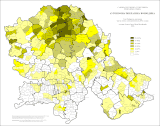





![Kniezsa's (1938) view on the ethnic map of the Kingdom of Hungary in the 11th century, based on toponyms. Kniezsa's view has been criticized by many scholars, because of its non-compliance with later archaeological and onomastics research, but his map is still regularly cited in modern reliable sources. One of the most prominent critics of this map was Emil Petrovici.[134]](http://upload.wikimedia.org/wikipedia/commons/thumb/3/3b/Ethnic_map_of_11th_century.jpg/150px-Ethnic_map_of_11th_century.jpg)
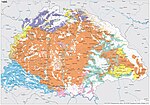
![The "Red Map",[135] based on the 1910 census. Regions with population density below 20 persons/km2 (52 persons/sq mi)[136] are left blank and the corresponding population is represented in the nearest region with population density above that limit. Red colour to mark Hungarians and light purple colour to mark Wallachians/Romanians.](http://upload.wikimedia.org/wikipedia/en/thumb/f/f4/Redmap.jpg/150px-Redmap.jpg)


